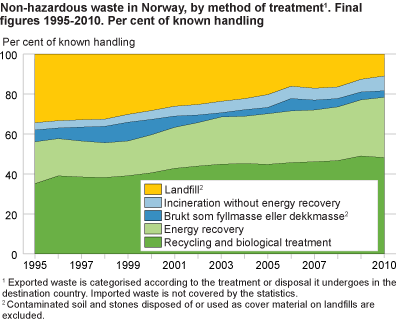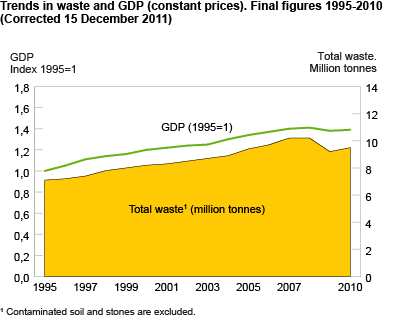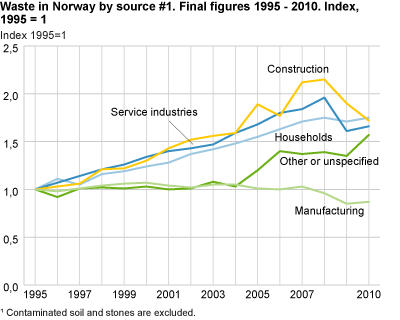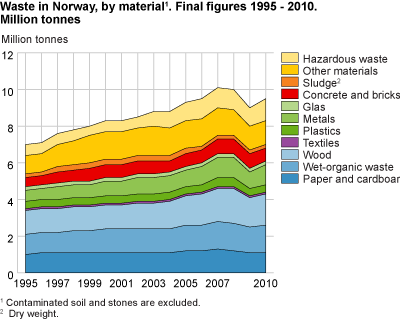Content
Published:
This is an archived release.
Major changes in landfilled waste
The total waste increased by 3 per cent last year. The amount disposed of at landfills has dropped substantially since 2007, and is at its lowest since 1995. On the other hand, the amount of contaminated soil and stones has increased.
The amount of landfilled waste went down by 600 000 tonnes, or almost a third, in 2010 compared to 2007. The amount of contaminated soil and stones increased by 70 000 tonnes. The amount going to landfill is the lowest ever recorded since the waste accounts were started in 1995. The total waste increased by 3 per cent last year, but is still below the 2007 level.
Political measures - such as a ban on the landfilling of biologically degradable waste from 1 July, tax on landfilling and improved infrastructure for recycling - seem to be the main reasons for the changes in landfilled waste amounts.
Less waste per value added
The waste amount has decreased more, and increased less, than the value added measured by GDP (constant prices) during the last years. Compared to the peak in 2007, the total waste is now 6 per cent lower, while GDP declined by 1 per cent1. In other words, more values are added per tonne of generated waste now than three years ago.
A greater focus on using production residues as raw material in manufacturing combined with political measures are plausible explanations. Since 1999, the authorities have been aiming to reduce the waste growth to a level considerably below the economic growth, as measured by GDP.
Households’ waste amount was almost unchanged from 2008 to 2010, while industrial waste dropped by 9 per cent. Households now generate 23 per cent of national waste.
Large drop in landfilled waste
The amount of waste going to landfill dropped by as much as 32 per cent in three years, to 1.4 million tonnes in 2010. Of this, organic biodegradable waste generating the greenhouse gas methane comprised only a quarter of a million tonnes. The landfilling of such waste types dropped by more than 60 per cent during these three years. The reduction is a result of political measures against landfilling and poor economical growth since autumn 2008.
Hazardous waste, most of it with poor recycling potential, made up 45 per cent of waste, making it by far the largest material category going to landfill, excluding contaminated soil and stones. Read more about hazardous waste here
The remaining landfilled waste was made up of materials like concrete, slag, glass, plastic and other materials that decompose extremely slowly. The material distribution of landfilled waste may be uncertain due to limited basic data.
In 2010, 5.7 million tonnes of non-hazardous waste was recovered, representing 82 per cent of all non-hazardous waste undergoing known treatment. In 2007, this share was 78 per cent. In real amounts, the recovery has slightly decreased, from 6.0 tonnes in 2007. The decrease is due to a substantial drop in the use of waste as cover material in the daily covering of landfills, following the drop in landfilled amounts. When cover material is excluded, the recovered amount increased by 0.1 million tonnes. Material recycling comprised 2.9 million tonnes, while energy recovery made up 2.1 million tonnes. Composting and other biological treatment amounted to 0.4 million tonnes.
Contaminated soil and stones going to landfill increased by 60 000 tonnes, to 1.1 million tonnes in 2010, compared to 2007. The amount used as cover material increased by 10 000 tonnes during the same period, and reached 260 000 tonnes in 2010. Together the amount of contaminated soil being disposed of or utilised on landfills reached 1.4 million tonnes. In addition to this are 350 000 tonnes of contaminated soil and stones put on industrial landfills, but these amounts are not available before 2010. Read more about waste handling here .
Concrete reduced the most - hazardous waste increased the most
The amount of concrete waste declined by 160 000 tonnes, or 19 per cent, from 2007. The main explanation is reduced construction activity. The amount of paper waste showed almost the same decline, by 150 000 tonnes or 13 per cent during the same period. Transition to electronic media is a plausible explanation.
The amount of hazardous waste increased by 110 000 tonnes, or 10 per cent, from 2007, and the largest increase came in 2010. The most important cause is a rise in waste brought on shore from oil extraction activities. Read more in the separate article on hazardous waste .
Less waste from building activity
The construction industry generated about 1.5 million tonnes of waste in 2010; a reduction of 10 per cent from the previous year. Waste from civil engineering is excluded. Read more about waste from construction and demolition in the separate article. The service industries generated 1.4 million tonnes of waste in 2010. Paper waste has declined significantly from 2008, while the other materials as a whole increased. Besides, more waste was delivered as sorted fractions. Read more in the separate article on waste from service industries .
Sewerage and waste management constitutes a separate industry in the waste accounts for the first time. Previously this industry was attached to the service industries. The sewerage and waste management industry generated 0.3 million tonnes of waste, mainly slag from incineration and sewer sludge. Residues from waste treatment, such as non-composted fractions and sorting residues, are excluded. Read more in water supply, sewerage, waste management and remediation activities, sales statistics .
Manufacturing industries generated 2.7 million tonnes of waste in 2010, which is highest among the industries. This is up 3 per cent from the previous year. Manufacturing thus comprises 28 per cent of the total waste amount. Wood, hazardous waste, slag and waste from production of food and beverages dominate. The figures on manufacturing waste in 2010 are based on the manufacturing waste survey 2008 and projections based on production value (constant prices) between 2008 and 2010. See the complementary article on manufacturing waste .
1 Corrected 15 December 2011 at 1315.| Total (excluding contaminated soil and stones) |
Paper, cardboard and pasteboard |
Metals | Plastics | Glas | Wood waste |
Textiles | Wet organic waste |
Concrete and bricks |
Sludge | Other | Hazardous waste | Contaminated soil and stones1 |
|||||||||||||||||||||||||||||||||||||||||||||||||||||||||||||||||||
|---|---|---|---|---|---|---|---|---|---|---|---|---|---|---|---|---|---|---|---|---|---|---|---|---|---|---|---|---|---|---|---|---|---|---|---|---|---|---|---|---|---|---|---|---|---|---|---|---|---|---|---|---|---|---|---|---|---|---|---|---|---|---|---|---|---|---|---|---|---|---|---|---|---|---|---|---|---|---|---|
| 1995 | 7 100 | 1 037 | 593 | 377 | 187 | 1 334 | 115 | 1 079 | 525 | 248 | 1 034 | 573 | 806 | ||||||||||||||||||||||||||||||||||||||||||||||||||||||||||||||||||
| 1996 | 7 171 | 1 071 | 633 | 384 | 180 | 1 332 | 119 | 1 093 | 546 | 246 | 1 000 | 565 | 728 | ||||||||||||||||||||||||||||||||||||||||||||||||||||||||||||||||||
| 1997 | 7 378 | 1 073 | 656 | 393 | 182 | 1 302 | 121 | 1 118 | 563 | 254 | 1 156 | 558 | 726 | ||||||||||||||||||||||||||||||||||||||||||||||||||||||||||||||||||
| 1998 | 7 805 | 1 107 | 711 | 400 | 190 | 1 305 | 122 | 1 195 | 647 | 252 | 1 326 | 550 | 681 | ||||||||||||||||||||||||||||||||||||||||||||||||||||||||||||||||||
| 1999 | 7 970 | 1 074 | 723 | 406 | 193 | 1 269 | 122 | 1 249 | 662 | 260 | 1 471 | 543 | 579 | ||||||||||||||||||||||||||||||||||||||||||||||||||||||||||||||||||
| 2000 | 8 176 | 1 118 | 758 | 414 | 199 | 1 300 | 120 | 1 256 | 651 | 264 | 1 484 | 611 | 410 | ||||||||||||||||||||||||||||||||||||||||||||||||||||||||||||||||||
| 2001 | 8 298 | 1 103 | 798 | 418 | 208 | 1 330 | 119 | 1 260 | 686 | 272 | 1 508 | 596 | 230 | ||||||||||||||||||||||||||||||||||||||||||||||||||||||||||||||||||
| 2002 | 8 457 | 1 086 | 860 | 413 | 217 | 1 360 | 118 | 1 293 | 694 | 279 | 1 535 | 602 | 157 | ||||||||||||||||||||||||||||||||||||||||||||||||||||||||||||||||||
| 2003 | 8 737 | 1 085 | 874 | 405 | 228 | 1 412 | 118 | 1 253 | 653 | 283 | 1 620 | 806 | 198 | ||||||||||||||||||||||||||||||||||||||||||||||||||||||||||||||||||
| 2004 | 8 902 | 1 145 | 870 | 403 | 231 | 1 484 | 119 | 1 345 | 626 | 262 | 1 520 | 898 | 277 | ||||||||||||||||||||||||||||||||||||||||||||||||||||||||||||||||||
| 2005 | 9 383 | 1 198 | 920 | 413 | 226 | 1 584 | 121 | 1 421 | 743 | 253 | 1 536 | 970 | 358 | ||||||||||||||||||||||||||||||||||||||||||||||||||||||||||||||||||
| 2006 | 9 696 | 1 247 | 1 017 | 442 | 225 | 1 653 | 123 | 1 433 | 707 | 248 | 1 500 | 1 102 | 1 108 | ||||||||||||||||||||||||||||||||||||||||||||||||||||||||||||||||||
| 2007 | 10 164 | 1 254 | 1 080 | 466 | 236 | 1 810 | 128 | 1 528 | 840 | 238 | 1 527 | 1 056 | 1 278 | ||||||||||||||||||||||||||||||||||||||||||||||||||||||||||||||||||
| 2008 | 10 153 | 1 196 | 1 119 | 483 | 240 | 1 858 | 133 | 1 534 | 850 | 219 | 1 425 | 1 097 | 1 525 | ||||||||||||||||||||||||||||||||||||||||||||||||||||||||||||||||||
| 2009 | 9 204 | 1 136 | 942 | 443 | 217 | 1 629 | 115 | 1 408 | 759 | 214 | 1 325 | 1 017 | 973 | ||||||||||||||||||||||||||||||||||||||||||||||||||||||||||||||||||
| 2010 | 9 454 | 1 107 | 1 066 | 439 | 209 | 1 660 | 117 | 1 493 | 684 | 204 | 1 313 | 1 162 | 1 698 | ||||||||||||||||||||||||||||||||||||||||||||||||||||||||||||||||||
| By source and material (2010) | |||||||||||||||||||||||||||||||||||||||||||||||||||||||||||||||||||||||||||||||
| Total | 9 454 | 1 107 | 1 066 | 439 | 209 | 1 660 | 117 | 1 493 | 684 | 204 | 1 313 | 1 162 | 1 698 | ||||||||||||||||||||||||||||||||||||||||||||||||||||||||||||||||||
| Households2 | 2 187 | 477 | 200 | 155 | 80 | 373 | 52 | 556 | 3 | 0 | 259 | 31 | 0 | ||||||||||||||||||||||||||||||||||||||||||||||||||||||||||||||||||
| Agriculture, forestry and fishing | 156 | 6 | 7 | 24 | 0 | 1 | 5 | 110 | 0 | 0 | 1 | 2 | 0 | ||||||||||||||||||||||||||||||||||||||||||||||||||||||||||||||||||
| Mining and quarrying | 376 | 2 | 59 | 2 | 0 | 4 | 0 | 5 | 0 | 0 | 6 | 297 | 0 | ||||||||||||||||||||||||||||||||||||||||||||||||||||||||||||||||||
| Manufacturing | 2 657 | 100 | 143 | 33 | 19 | 696 | 6 | 401 | 43 | 95 | 508 | 612 | 0 | ||||||||||||||||||||||||||||||||||||||||||||||||||||||||||||||||||
| Electricity, gas and water supply | 39 | 0 | 9 | 0 | 0 | 1 | 0 | 1 | 0 | 0 | 1 | 27 | 0 | ||||||||||||||||||||||||||||||||||||||||||||||||||||||||||||||||||
| Construction | 1 544 | 62 | 84 | 39 | 73 | 256 | 11 | 73 | 634 | 0 | 299 | 13 | 0 | ||||||||||||||||||||||||||||||||||||||||||||||||||||||||||||||||||
| Service industries | 1 366 | 364 | 103 | 120 | 36 | 181 | 32 | 346 | 3 | 3 | 93 | 86 | 0 | ||||||||||||||||||||||||||||||||||||||||||||||||||||||||||||||||||
| Sewerage and waste management | 322 | 0 | 5 | 0 | 0 | 0 | 0 | 0 | 0 | 106 | 147 | 64 | 0 | ||||||||||||||||||||||||||||||||||||||||||||||||||||||||||||||||||
| Other or unspecified | 807 | 95 | 456 | 67 | 0 | 147 | 12 | 0 | 0 | 0 | 0 | 30 | 1 698 | ||||||||||||||||||||||||||||||||||||||||||||||||||||||||||||||||||
| By treatment/disposal and material (2010)3 | |||||||||||||||||||||||||||||||||||||||||||||||||||||||||||||||||||||||||||||||
| Total | 9 454 | 1 107 | 1 066 | 439 | 209 | 1 660 | 117 | 1 493 | 684 | 204 | 1 313 | 1 162 | 1 698 | ||||||||||||||||||||||||||||||||||||||||||||||||||||||||||||||||||
| Sorted for material recovery | 3 090 | 650 | 993 | 81 | 87 | 378 | 12 | 343 | 89 | 88 | 182 | 187 | 0 | ||||||||||||||||||||||||||||||||||||||||||||||||||||||||||||||||||
| Biological treatment | 446 | 0 | 0 | 0 | 0 | 149 | 0 | 297 | 0 | 0 | 0 | 0 | 0 | ||||||||||||||||||||||||||||||||||||||||||||||||||||||||||||||||||
| Energy recovery | 2 253 | 254 | 0 | 181 | 0 | 984 | 56 | 535 | 0 | 42 | 47 | 4 155 | 0 | ||||||||||||||||||||||||||||||||||||||||||||||||||||||||||||||||||
| Filling compound and cover material | 226 | 2 | 0 | 0 | 4 | 8 | 0 | 8 | 16 | 13 | 176 | 0 | 0 | ||||||||||||||||||||||||||||||||||||||||||||||||||||||||||||||||||
| Incineration without energy recovery | 557 | 66 | 59 | 51 | 64 | 86 | 17 | 159 | 0 | 0 | 15 | 442 | 0 | ||||||||||||||||||||||||||||||||||||||||||||||||||||||||||||||||||
| Landfill | 1 350 | 63 | 15 | 56 | 13 | 54 | 18 | 71 | 132 | 12 | 328 | 588 | 1 698 | ||||||||||||||||||||||||||||||||||||||||||||||||||||||||||||||||||
| Other final treatment | 191 | 0 | 0 | 0 | 0 | 0 | 0 | 0 | 0 | 0 | 0 | 191 | 0 | ||||||||||||||||||||||||||||||||||||||||||||||||||||||||||||||||||
| Other or unspecified | 1 340 | 73 | 0 | 70 | 41 | 0 | 14 | 79 | 447 | 49 | 565 | 0 | 0 | ||||||||||||||||||||||||||||||||||||||||||||||||||||||||||||||||||
| 1 | Break in the time series: Industrial landfills are missing before 2010. The amount of contaminated soil and stones sent to industrial landfills in 2010 was 348 000 tonnes, of which 50 tonnes used as cover material. |
| 2 | 2 Includes scrapped cars and motor bikes, and paper burnt at home. |
| 3 | 3 Exported waste is categorised according to the treatment or disposal it undergoes in the destination country. Imported waste is not covered by the statistics. |
| 4 | Corrected 14 December 2011 at 13:50 p.m. |
Waste and contaminated soil and stones in the waste accountsWaste in the waste accounts includes all waste, also hazardous waste, but excludes contaminated soil and stones. The waste is however counted only once. This means that residues from waste treatment, such as non-composted fractions from composting plants and sorting residues from sorting plants are excluded. However, slag and other residues from waste incineration are included, as these matters are highly transformed and thus have the character of being a new material. Contaminated soil and stones is explained in the separate article on waste treatment. |
Contact
-
Camilla Skjerpen
E-mail: camilla.skjerpen@ssb.no
tel.: (+47) 48 22 72 14




